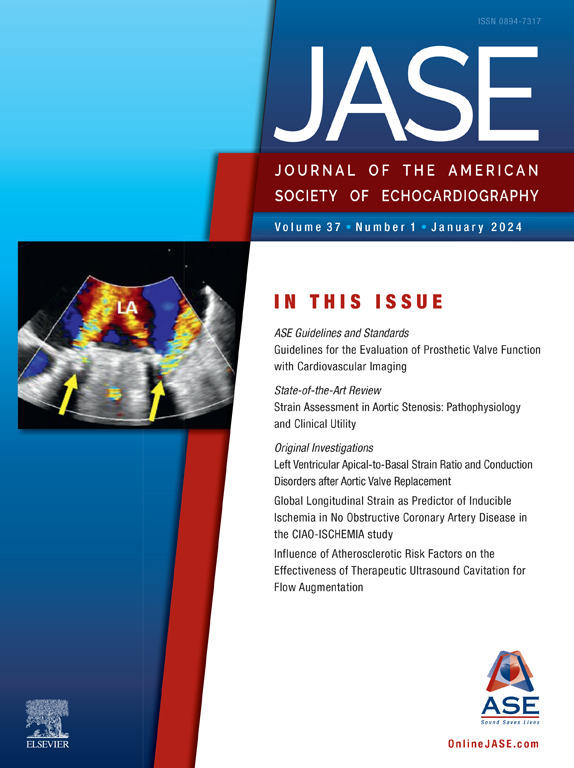Prognostic Value of Echocardiographic Coupling Metrics in Systemic Sclerosis–Associated Pulmonary Vascular Disease
IF 5.4
2区 医学
Q1 CARDIAC & CARDIOVASCULAR SYSTEMS
Journal of the American Society of Echocardiography
Pub Date : 2025-02-01
DOI:10.1016/j.echo.2024.09.010
引用次数: 0
Abstract
Background
Ineffective right ventricular (RV) adaptation to increasing pulmonary arterial (PA) afterload in pulmonary vascular disease (PVD) significantly contributes to morbidity and mortality. Pulmonary vascular disease in systemic sclerosis (SSc) arises through various mechanisms, yet detecting abnormal contractile response remains challenging. Here we examine whether echocardiographic RV-PA coupling metrics correlate with invasive pressure-volume (PV) loops, enhancing the prediction of adverse clinical outcomes in SSc-PVD patients.
Methods
Prospectively enrolled patients with SSc-PVD with paired echocardiogram and PV loops were included. Linear regression and receiver-operating curve analysis were used to assess the relationship between tricuspid annular plane systolic excursion/PA systolic pressure (PASP), fractional area change/PASP, tissue Doppler velocityS’/PASP, and RV free wall strain (RVFWS)/PASP and coupling thresholds defined by end-systolic to end-arterial elastance (Ees/Ea), obtained by the multibeat method. The contribution of right atrial strain (RAS) to RV-PA coupling parameters was also investigated. Kaplan-Meier analysis was used to identify the relationship between coupling ratios and composite outcomes including clinical worsening, lung transplant, and death.
Results
Forty-two patients with SSc were studied, 91% female, with a mean age of 59 ± 12 years and varying degrees of PVD: mean pulmonary artery pressure 29.5 ± 12.8 mm Hg, PVR 4.7 ± 4.2 WU, and PCWP 10.3 ± 4.1 mm Hg. Echocardiographic coupling metrics including tricuspid annular plane systolic excursion/PASP, fractional area change/PASP, tissue Doppler velocity S’/PASP, RVFWSglobal and RVFWSbasal/PASP, and RASreservoir/PASP were linearly associated with Ees/Ea. At cut points obtained through receiver-operating curve analysis, all ratios were predictive of RV-PA uncoupling, defined by Ees/Ea, and composite outcomes. Additionally, RASreservoir/RVFWS correlated with Ees/Ea even after adjustment for PASP, suggesting that diminished RAS further impacts RV performance and coupling.
Conclusion
Echocardiographic RV-PA coupling ratios strongly correlate with invasive Ees/Ea and predict adverse clinical outcomes in SSc patients across the spectrum of PVD. Further, we demonstrate how RAS impacts RV performance. These findings may refine risk stratification and prognostication in this at-risk cohort.
系统性硬化症相关肺血管疾病超声心动图耦合指标的预后价值
背景:在肺血管疾病(PVD)中,右心室(RV)对肺动脉(PA)后负荷增加的适应不良是导致发病率和死亡率的重要原因。系统性硬化症(SSc)中的肺血管病是通过各种机制引起的,但检测异常收缩反应仍具有挑战性。在此,我们研究了超声心动图 RV-PA 耦合指标是否与有创压力-容积(PV)环路相关,从而加强对 SSc-PVD 患者不良临床结局的预测:方法:纳入前瞻性入组的SSc-PVD患者,这些患者的超声心动图和PV环路成对。采用线性回归和接收者操作曲线(ROC)分析评估三尖瓣环面收缩期偏移(TAPSE)/PA 收缩压(PASP)、分数面积变化(FAC)/PASP、组织多普勒速度(TDI S')/PASP、RV 游离壁应变(RVFWS)/PASP 与多搏法获得的收缩末至动脉末弹性(Ees/Ea)定义的耦合阈值之间的关系。此外,还研究了右心房应变(RAS)对 RV-PA 耦合参数的贡献。采用 Kaplan-Meier 分析确定耦合率与临床恶化、肺移植和死亡等综合结果之间的关系:42 名 SSc 患者接受了研究,他们的平均年龄为 59 ± 12 岁,91% 为女性,存在不同程度的 PVD:mPAP 29.5 ± 12.8 mmHg、PVR 4.7 ± 4.2 WU、PCWP 10.3 ± 4.1 mmHg。超声心动图耦合指标(包括 TAPSE/PASP、FAC/PASP、TDI S'/PASP、RVFWSglobal 和 RVFWSbasal/PASP、RASreservoir/PASP)与 Ees/Ea 呈线性相关。在通过 ROC 分析获得的切点上,所有比率都能预测由 Ees/Ea 定义的 RV-PA 解偶联和综合结果。此外,即使在调整 PASP 后,RASreservoir/RVFWS 仍与 Ees/Ea 相关,这表明 RAS 的减弱进一步影响了 RV 性能和耦合:结论:超声心动图 RV-PA 耦合比与有创 Ees/Ea 密切相关,可预测 SSc 患者各种心血管疾病的不良临床结局。此外,我们还证明了 RAS 对 RV 性能的影响。这些发现可能会完善这一高危人群的风险分层和预后。
本文章由计算机程序翻译,如有差异,请以英文原文为准。
求助全文
约1分钟内获得全文
求助全文
来源期刊
CiteScore
9.50
自引率
12.30%
发文量
257
审稿时长
66 days
期刊介绍:
The Journal of the American Society of Echocardiography(JASE) brings physicians and sonographers peer-reviewed original investigations and state-of-the-art review articles that cover conventional clinical applications of cardiovascular ultrasound, as well as newer techniques with emerging clinical applications. These include three-dimensional echocardiography, strain and strain rate methods for evaluating cardiac mechanics and interventional applications.

 求助内容:
求助内容: 应助结果提醒方式:
应助结果提醒方式:


